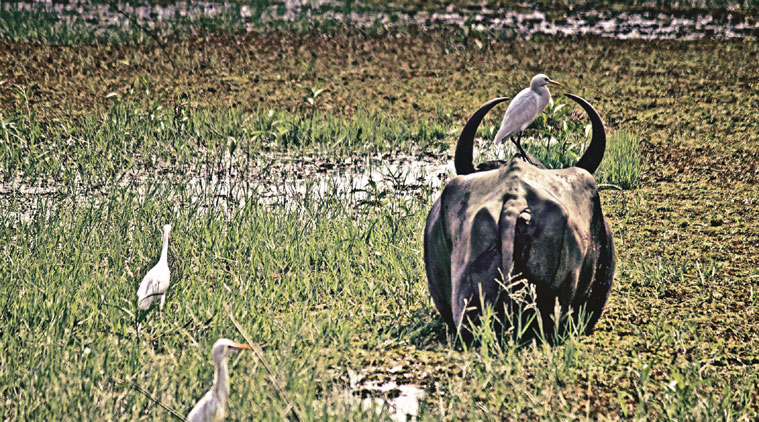How the plant and animal world look out for each other to survive
Living creatures have evolved partnerships where, for the most part, they look out for each other, and “live together” even when they are not remotely related to each other.
 Living creatures have evolved partnerships where, for the most part, they look out for each other, and “live together” even when they are not remotely related to each other. (Source: Ranjit Lal)
Living creatures have evolved partnerships where, for the most part, they look out for each other, and “live together” even when they are not remotely related to each other. (Source: Ranjit Lal)
“Kill or be killed, eat or be eaten” — those are the cardinal laws of nature, right? Sure, except that if they were applied in toto, there’d soon be nothing left to kill or eat. And to ensure that doesn’t happen, living creatures have evolved partnerships where, for the most part, they look out for each other, and “live together” even when they are not remotely related to each other.
What a scandal is that! The moral police might froth and fume, but it’s too late, because such “live-in” relationships exist nearly everywhere in nature! They’re there in the cops’ (and everyone else’s) guts: an army of bacteria bivouacking cosily inside our intestines, being wined and dined by us and warding off the nasties which can make us sick. Nature is full of these unlikely romances.
It’s called symbiosis, which in Greek means, “living together”. It’s the long term interaction and relationship between different biological species, usually for their mutual benefit. But in reality, like in marriage, there are several ways this relationship can go: it can benefit both partners equally, it can benefit one partner, but not harm the other; it can benefit one partner to the detriment (even up to the point of death) of the other. The partners can live on each other, in each other and close to each other. Scientists have, of course, defined these terms, but you can find that out from the great god Google. Some of the stories, however, are worth recounting.
Deep below the earth, roots stretch out searching for water, minerals and nourishment for the plant or tree being supported above. A fungus grows over these roots, and then spreads on its own to areas where the roots cannot penetrate. From here, they gather minerals for nourishment and return these to the roots, which are invigorated and push on aggressively. In exchange, the roots supply the fungus with carbohydrates, which the fungus requires but is unable to manufacture on its own because it cannot photosynthesise. The bullhorn acacia of Africa plays host to ferocious ants which set up cantonments in the massive hollowed out thorns of the plant. The plant produces nectar and nodules of food (called beltian bodies) for the ants, which in turn, ensure no other living creature (usually bovine) takes a bite out of it, even to the extent of clearing any other plant that dares grow nearby. Perhaps, the most famous example of symbiosis in plants is that between the fig tree and the fig wasp, where each species of fig tree (and there are around 1,000) has a designer species of wasp, which pollinates it and lays its eggs in it. No other will do, and if the fig wasp goes extinct, tragically, so does the tree.
The most obvious example from the animal kingdom is the relationship between birds (egrets, mynas, drongoes et al) and bovines. The birds perch on the backs of grazing animals, picking off ticks and mites and snapping up the insects disturbed by the animals’ hooves as they move through the grass, thus eating well with little expenditure of energy. In return, the animals are freed of bloodsucking parasites and the birds also serve as an early warning system against predators trying to sneak up close. (Of course, some birds, like the oxpecker have taken advantage of this — they clean up the ticks but also enjoy a snifter of blood from the bite site.) Ticks and mites are themselves examples of a one way relationship — parasitical — where one partner benefits to the detriment of the other. Plovers ask crocodiles to “open wide” so they can clean their teeth, and ostriches and zebras look out for each other, the birds’ have great eyesight, the zebras great hearing and smell, their defence is complete. That handsome dude — the warthog — will lie down luxuriously as banded mongooses scour its bristly hair for ticks and fleas. Honeyguides show ratels (honey badgers) the way to beehives and get a share of the sweet spoils. Deep underwater, sharks and other fish await their turns at “cleaning stations” where they get the equivalent of skin-cleansing treatment at a spa from cleaner fish.
Of course, we’ve got into the act too: There are now several (often food) plants, which cannot do without our help to reproduce — maize and corn are handy examples. We’ve “cultured” them such that they are unable to scatter their seeds on their own and need human help to do so.
And of course, there are betrayals and scandals galore. The young of the cereal weevil, hosts a particular gut bacteria in special chambers called bacteriomes to keep them safe from being attacked by their immune system, and where they get five-star treatment. But once the weevil reaches adulthood, these bacteriomes along with the bacteria vanish. Apparently, these bacteria are very adept in producing two particular amino-acids which the weevil needs in order to develop its hard outer shell as it reaches adulthood, and which it cannot get enough of from its own diet. Hence, as it grows, it entertains this bacteria and when fully grown shuts down the “suites” and dissolves the bacteria.
We have, of course, adapted and developed this theme (within our own species), like no other. “You scratch my back and I’ll scratch yours” — how many times has that been the mantra in politics, business, love and virtually everything we do?
Ranjit Lal is an author, environmentalist and birdwatcher
The story appeared in print with the headline Matters of Convenience




- 01
- 02
- 03
- 04
- 05























